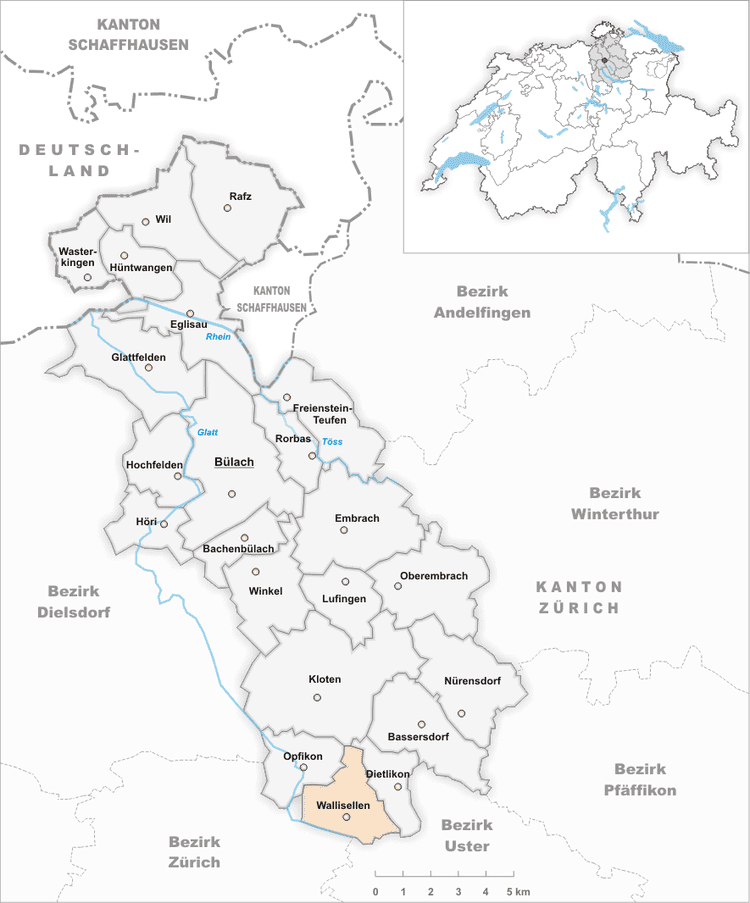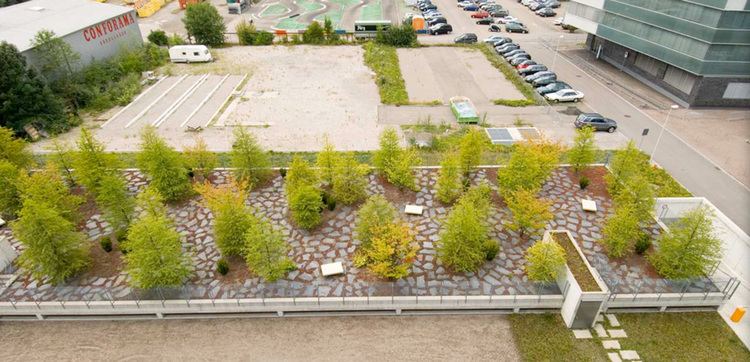Country Population 12,817 (Dec 31, 2008) District Bulach | Elevation 431 m Area 6.43 km2 | |
 | ||
Map of Wallisellen
Wallisellen is a municipality in the district of Bülach in the canton of Zürich in Switzerland, and belongs to the Glatt Valley (German: Glattal).
Contents
- Map of Wallisellen
- Fahrt durch wallisellen schweiz switzerland
- Driving in Zrich to Wallisellen Switzerland 102009 HD Sanierung Hardbrcke
- History
- Geography
- Demographics
- Economy
- Transportation
- Places of interest
- Personalities
- Sport and Association
- Language and Rhyme
- References

Fahrt durch wallisellen schweiz switzerland
Driving in Zürich, to Wallisellen Switzerland (10/2009) HD, Sanierung Hardbrücke
History

The first settlement at Wallisellen dates from 58 BC. The municipality Wallisellen has its origin between 400 and 700 BC, after the Germanic migration of the peoples. Wallisellen is named according to both parts "Walchen" and "Seller". The Germanic peoples described as «Walchen» its Celtic and romanic neighbours (look at Walensee Lake of the Walchen). The word "Seller" stands for immigrated farmers, in contrast to long-established farmers, who cultivated small and modest farm. Linguists think that name comes along because Franks or Alemanni gave the name "Wallisellen" to a small farmer settlement, which was inhabited or founded from Celts or Romans.
In 1916, the municipality of Rieden merged with Wallisellen.
With inauguration of the NOB-line Zürich–Wallisellen–Winterthur on 25 June 1856 Wallisellen had its first connexion with the Swiss railway network. In 1916, the municipality of Rieden merged with Wallisellen. In interwar period Wallisellen developed from a village to a growing suburb-municipality of Zurich, but didn't want to have town charter.
During Second World War, Wallisellen took part hugely in the "Anbauschlacht" ("cultivation battle", i.e. increase in domestic food production due to reductions in imports) (Plan Wahlen). In 1958 the Roman Catholic church of St. Antonius was built.
Geography
Wallisellen has an area of 6.5 km2 (2.5 sq mi). Of this area, 23.8% is used for agricultural purposes, while 20.1% is forested. Of the rest of the land, 54.5% is settled (buildings or roads) and the remainder (1.5%) is non-productive (rivers, glaciers or mountains).
Demographics
Wallisellen has a population (as of 31 December 2016) of 15,934. As of 2007, 25.5% of the population was made up of foreign nationals. Over the last 10 years the population has grown at a rate of 11.8%. Most of the population (as of 2000) speaks German (83.2%), with Italian being second most common ( 3.8%) and Serbo-Croatian being third ( 1.9%).
In the 2007 election the most popular party was the SVP which received 38.6% of the vote. The next three most popular parties were the SPS (19%), the FDP (15.4%) and the CSP (9.8%).
The age distribution of the population (as of 2000) is children and teenagers (0–19 years old) make up 19.1% of the population, while adults (20–64 years old) make up 64.4% and seniors (over 64 years old) make up 16.5%. In Wallisellen about 76.9% of the population (between age 25-64) have completed either non-mandatory upper secondary education or additional higher education (either university or a Fachhochschule).
Wallisellen has an unemployment rate of 3.21%. As of 2005, there were 50 people employed in the primary economic sector and about 16 businesses involved in this sector. 3085 people are employed in the secondary sector and there are 137 businesses in this sector. 8950 people are employed in the tertiary sector, with 731 businesses in this sector.
Economy
The large Shopping Center Glatt is an indoor shopping mall in the municipality, which opened in 1975.
Between it and Wallisellen railway station lies Richti Shopping, an open-air shopping center, which was officially opened in winter 2013 and was completed by end of 2014.
Transportation
Wallisellen Bahnhof is a stop of the Zürich S-Bahn on the lines S8, S14, S19 and on the Stadtbahn Glattal light rail system. It takes 9-10 minutes to get to Zürich Hauptbahnhof from the Wallisellen railway station.
Places of interest
Personalities
Sport and Association
The largest sports club of Wallisellen is the «FC Wallisellen» (Football club Wallisellen), which first team in the season 06/07 was promoted to the 2. league. Other successful sports clubs are the «EHC Wallisellen» (Ice hockey club Wallisellen) and «Faustball Wallisellen» (Fistball Wallisellen). Also very active is the «TV Wallisellen» (Gymnastic club Wallisellen). That club organises since 1993 the «Walliseller Lauf» (Run of Walisellen), all of the earnings go to 100 pourcent to kids, who are suffering on cancer. In Wallisellen there are twoo scout troops: scout troops «Gryfensee» and scout troop «Winkelried».
Language and Rhyme
Wallisellen is known in German part of Switzerland due to a rhyme: «Aazelle, Bölle schelle, d'Chatz gaht uf Walliselle, chunnt si wider hei, hät si chrummi Bei, piff paff puff und du bisch (ehr und redlich) duss».
German Translation: «Anzählen, Zwiebeln schälen, die Katze geht nach Wallisellen, kommt sie wieder nach Hause, hat sie krumme Beine, pfiff paff und du bist (ehr und redlich) draussen».A song of the Bernese dialect-band Stiller Has has the track «Walliselle».
Dialect: Today the native German-speaking population speaks a mixture of Swiss German dialects. That's a levelled Zurich-German with a tendency of integration of elements of German is widely spread. Long-time residents recognises only in its pronunciation of the toponym Wallisellen with sharp «s».
